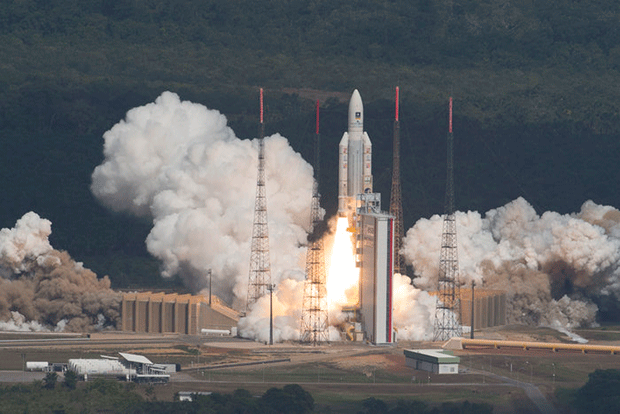New members brought into the Galileo family

On 12 December four new Galileo satellites were successfully launched from the Kourou spaceport (French Guiana). In the next few days the satellites will reach their corresponding orbits and the European GNSS agency (GSA) will carry out tests for half a year to check they work properly.
Picture: ESA-S Corvaja
A sizeable percentage of Europe’s economy is now calling for geolocation services. In the early years of 2000, in response to this demand, the European Union began to design and develop its own satellite navigation system, culminating years later in the Galileo program. This represents the first joint initiative of the European Space Agency and the European Commission, run from the GSA (European GNSS Agency) in Prague (Czech Republic) and financed by the European Union itself.
Information on traffic, emergency services, meteorology, agriculture and fishery applications are only some of the many Galileo-enabled uses. The European GPS, as some have dubbed it, has been capable of providing precise positioning and navigation information since 2016, so anyone with an enabled device has been able to benefit from its services.
Galileo currently works jointly with other navigation systems such as America’s Global Positioning System (GPS), Russia’s GNSS (GLONASS) and China’s BeiDuo; and the constellation is scheduled for completion by 2020.
This satellite launch together with next year’s launch of another quartet will bring the 24‑satellite Galileo constellation to the point of completion, plus 6 orbital spares, in 3 orbital planes, providing four worldwide services: Open Service (OS) of positioning and timing; the Commercial Service (CS); the Public Regulated Service (PRS) for authorized users and the Search and Rescue Service (SAR), Europe’s contribution to the LEOSAR configuration.
GMV in Galileo
GMV has primed the provision of timing and geodetic services as well as co-leading development of the European Union’s GNSS Service Centre (GSC) and leading development of the demonstrator of Galileo’s Commercial Service (CS), to vet the system capacity for providing commercial High-Accuracy (HA) services.
In the ground segment GMV has developed critical subsystems of the Ground Control Segment (GCS) and the Ground Mission Segment (GMS), such as the OSPF (Orbit & Synchronisation Processing Facility), IPF (Integrity Processing Facility), SPF (Service Product Facility), FDF (Flight Dynamics Facility) and MNE (MDDN Network equipment). It is taking part in complete system design and engineering tasks within the In-Orbit Validation phase (IOV) plus the Full Operational Capability (FOC) phase, which completes the ground and space infrastructure developed during the IOV phase.
The European Commission also awarded GMV the framework contract for developing the Galileo Reference Center (GRC) plus the framework contract for supply of the Return Link Service Provider (RLSP) and the program’s Search and Rescue Service (SAR). Furthermore, 15 GMV employees are providing in-situ support for Galileo operations in Germany’s aerospace control center (DLR).
GMV has likewise been working for years on GNSS service apps, such as the precise point positioning (PPP) services or development of receivers for specific apps like PRS or IoT.